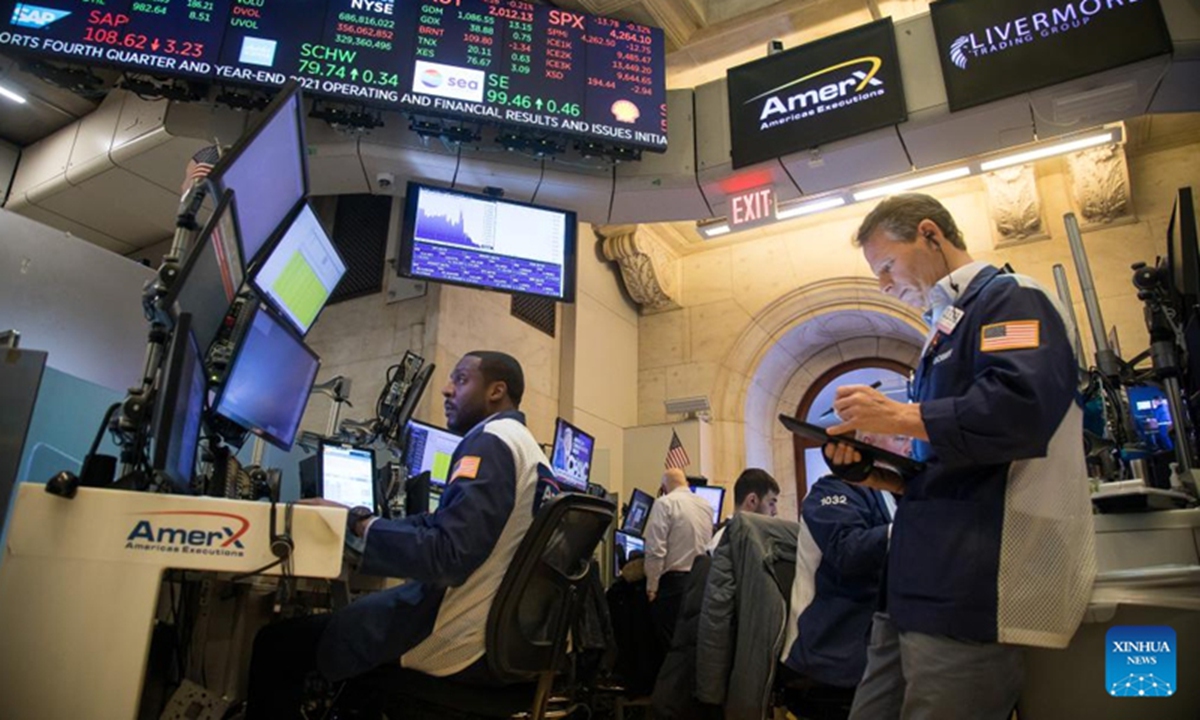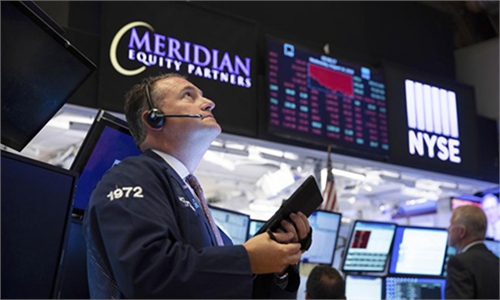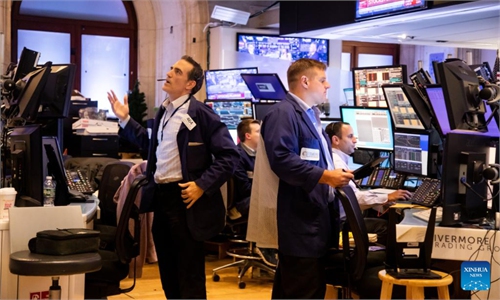
Traders work on the floor of the New York Stock Exchange (NYSE) in New York, the US.Photo: Xinhua
The market volatility on Wall Street shows no sign of subsiding, as traders are unnerved by the increasingly hawkish remarks from the Federal Reserve policymakers that they will continue to raise interest rates to rein in inflation, which has remained stubbornly elevated. Higher interest rates will channel capital away from stock investments back to bank savings, and be bad for the market.On Tuesday, US stocks again nosedived after fourth-quarter earnings and forecasts from mega American retailers including Walmart and Home Depot raised serious concerns about the strength of the US consumer economy. The retailers reflected that higher consumer prices will weigh on consumption while stretching their balance sheets . As consumption makes up 70 percent of the US' annual GDP, any weakening will mean the US economy has a high possibility of sliding into a recession during 2023.
As a result, investors moved to sell off their holdings. The S&P 500 index plunged 2 percent on Tuesday, falling below the key 4,000 level, while the Dow Jones Industrial Average shed nearly 700 points, or 2.1 percent. The technology-heavy Nasdaq Composite tanked by as much as 2.5 percent.
To make things worse, major investment banks in the US are no longer sanguine about the stock market outlook for the first half of this year, spooked by the rising risk of a recession because of the Fed's vow to contain inflation by further raising interest rates. Cleveland Fed president Loretta Mester said that she would have favored raising rates by 50 basis points earlier this month rather than the smaller quarter-point rate increase her colleagues opted for. During the Fed's next policymaking session in March, more Fed members have indicated they will pivot to another 50-basis-point raise.
Naturally, US equities are unlikely to hit bottom until the Fed concludes its aggressive interest-rate hike campaign and starts cutting rates. The central bank already voted to raise rates eight consecutive times to a range of 4.5 percent to 4.75 percent - the highest level since 2008 -- and the policymakers have signaled that a couple more increases are on the table over the first half of 2023.
US inflation measured by the consumer price index rose 6.4 percent in January, slightly down from December. An array of hotter-than-expected economic data reports - including the blowout January jobs report and the spiraling factory-price PPI - point to the pervasiveness of high consumer prices, raising the specter of a higher peak rate at 5.5-5.75 percent or even higher to 6 percent.
And, the Fed is unlikely to reduce rates in 2023 or the first half of 2024, analysts say. The previous market hope that the Fed's policy tightening cycle will come to an end late this year may not materialize, as inflation seems to be deeply entrenched across the entire US economic system. Walmart warned on Tuesday that it was cautious about the outlook of the economy, as US consumers remain under pressure from inflation and were opting to shop for lower-priced items.
As a result, more bearish voices are gaining prominence. For instance, some analysts predict a massive correction, suggesting the S&P 500 index might tumble to 3,000 points in 2023, down some 25 percent from current levels. US equities initially rallied in early 2023, although they have lost much of that momentum amid Fed's rate-hike fears. It is true that elevated US inflation will be difficult to quell after taking root across the broader services sector.
The US central bank raised rates by a cumulative 425 basis points in 2022, including four consecutive 75 basis points raises, which is unprecedented in its history. The aggressive policy tightening has dampened US economic activity, with most economists predicting a severe economic slowdown this year.
The paradox before Fed policymakers is that they don't know how high and how long they should continue to raise the rates that will be just appropriate to rein in elevated inflation, but not too restrictive to cause a deep recession in the US. Since December, the pace of Fed increases in borrowing costs has been scaled back. By all metrics, it is a tough job for any central bank to avoid overdoing it with high-than-needed interest rates and put an economy on ice.
Federal Reserve chairman Jerome Powell and other Fed officials have stressed that they need to see clear signals that inflation has truly eased before calling a pause to policy tightening. "Price stability is the bedrock of a healthy economy and provides the public with immeasurable benefits over time", Powell said in a recent policy address. "Restoring price stability when inflation is high requires measures that are not popular in the short term, as we raise interest rates to slow the economy."
Market traders and investors are fretting over inflation and the path forward for interest rates, as they await the Personal Consumption Expenditures (PCE) price index - the US central bank's most closely watched assessment of how quickly prices are rising across the economy - which is set for release on Friday.
The author is an editor with the Global Times. bizopinion@globaltimes.com.cn



